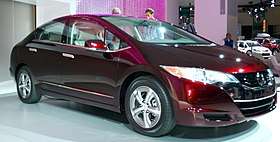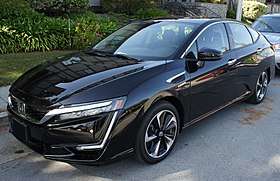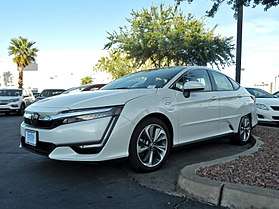Honda Clarity
| Honda Clarity | |
|---|---|
|
2017 Honda Clarity FCV | |
| Overview | |
| Manufacturer | Honda |
| Production |
2008–2014 (Honda FCX Clarity) 2016–present (Honda Clarity) |
| Body and chassis | |
| Class | Mid-size luxury car[1] |
| Body style | 4-door sedan |
| Layout | FF layout |
The Honda Clarity is a nameplate used by Honda on alternative fuel vehicles. It was initially used only on hydrogen fuel-cell electric vehicles such as the 2008 Honda FCX Clarity, but in 2017 the nameplate was expanded to include the battery-electric Honda Clarity Electric and the plug-in hybrid electric Honda Clarity Plug-in Hybrid, in addition to the next generation Honda Clarity Fuel Cell.
Honda FCX Clarity (2008–2014)
| FCX Clarity | |
|---|---|
 | |
| Overview | |
| Manufacturer | Honda |
| Also called | Honda Clarity |
| Production | 2008–2014 |
| Assembly | Takanezawa Plant, Takanezawa, Japan [2] |
| Designer | Sachito Fujimoto |
| Body and chassis | |
| Class | Mid-size luxury car |
| Body style | 4-door sedan |
| Layout | FF layout |
| Related | FCX Concept |
| Powertrain | |
| Electric motor | Fuel cell-powered 100 kW (130 hp) |
| Transmission | Single Speed, Direct Drive |
| Range | 240 mi (390 km) (EPA) |
| Dimensions | |
| Wheelbase | 2,800 mm (110.2 in) |
| Length | 4,834 mm (190.3 in) |
| Width | 1,847 mm (72.7 in) |
| Height | 1,468 mm (57.8 in) |
| Curb weight | 1,600 kg (3,528 lb) |
| Chronology | |
| Predecessor | Honda FCX |
| Successor | Honda Clarity Fuel Cell[3] |
History
The Honda FCX Clarity is based on the 2006 Honda FCX Concept and only available as a hydrogen fuel-cell electric vehicle. The FCX Clarity had electric car qualities such as zero emissions while offering five minute refueling times and long range in a full function large sedan. It was the first hydrogen fuel cell vehicle available to retail customers.[4]
Production began in June 2008 with leasing in the U.S. commenced in July 2008.[5] It was introduced in Japan in November 2008. The FCX Clarity was available for lease in the U.S., Japan and Europe. In the U.S., it was only available to customers who live in Southern California where several hydrogen fuel stations are available.[6] As of July 2010, a total of 20 FCX Clarity cars were leased for US$600 a month, including collision coverage, maintenance, roadside assistance and hydrogen fuel.[6] There were around 10 others on lease in Japan and another 10 in Europe.[4][6] One of the reasons for such a low number of cars in the U.S. was a lack of hydrogen filling stations.[6] In 2014 Honda announced to phase out the FCX Clarity. From 2008 to 2014, Honda leased a total of 46 FCX units in the US.[7]
Specifications
The FCX Clarity electrical power comes from a 100 kW Honda Vertical Flow (V Flow) hydrogen fuel cell stack whereby electricity is supplied on demand. In common with many electric vehicles, the car has regenerative braking and uses a separate battery to store energy recovered during braking.
The electric motor is based on the motor used in the EV Plus, rated at 134 horsepower (100 kW) and 189 lb⋅ft (256 N⋅m) torque @0-3056 rpm. The range on a full hydrogen tank (4.1 kg @ 5000psi) is EPA certified at 240 miles (~386 km).[8] The vehicle is estimated to get about 77 miles (123.9 km) per kilogram hydrogen in the city, 67 miles (107.8 km) per kilogram highway and 72 miles (115.9 km) per kilogram in combined driving.[9]
Design
The FCX Clarity is about 4 inches shorter than a 2008 Honda Accord. It comes with an innovative cockpit: the display in the dashboard includes a dot that changes color and size as hydrogen consumption grows, to make it easier for the driver to monitor their driving efficiency. A separate display shows the battery power level and another shows motor output. A speedometer is placed above the cockpit display, to make it easy for the driver to keep eyes on the road. In the interior, upholstery on the seats and door linings are made with Honda's Bio-Fabric that is derived from plants which cuts CO2.[9][10]
Production
The FCX Clarity was produced in Japan at a dedicated fuel-cell-vehicle assembly line in the Honda Automobile New Model Center (Takanezawa-machi, Shioya-gun, Tochigi Prefecture). The fuel cell stack itself is produced at Honda Engineering Co., Ltd. (Haga-machi, Haga-gun, Tochigi Prefecture).
It is reported that Honda plans to offer hydrogen fuel cell vehicle at costs competitive with gasoline mid-size cars by 2020 although its 2005 hand-built predecessor to the Clarity cost about $1 million.[4]
In July 2014 Honda announced the FCX Clarity would be discontinued and replaced by a new and higher-volume hydrogen fuel-cell vehicle to be introduced.[7]
Running costs
It is reported in 2009 that hydrogen made from natural gas cost about $5 to $10 per kilogram in California, and after compression cost and transportation cost, retails for $12-$14 per kilogram. Although it was more than double the equivalent amount of gasoline during the summer of 2009, fuel-cell cars have double the efficiency of similar models with a gasoline engine. The FCX Clarity averaged 60 miles per kilogram of hydrogen.[11]
Features
The FCX Clarity's features include an AM-FM car radio with CD player, integration for iPod and iPhone, a USB port, auxiliary input, a voice-activated GPS navigation system, XM satellite radio, cloth seating surfaces, Bluetooth, and digital instrumentation.
Reception
Since the car's unveil at the 2007 Los Angeles Auto Show, it was reported in May 2008 there were 50,000 people inquiring about the car through its Web site.[5]
Honda Clarity (2016–present)
Fuel Cell
| Clarity Fuel Cell | |
|---|---|
 | |
| Overview | |
| Manufacturer | Honda |
| Also called | Honda Clarity FCV |
| Production | 2016–present |
| Body and chassis | |
| Class | Mid-size luxury car |
| Body style | 4-door sedan |
| Layout | FF layout |
| Powertrain | |
| Electric motor | Fuel cell-powered 103 kW (138 hp) |
| Range | 366 mi (589 km) (EPA) |
| Dimensions | |
| Wheelbase | 2,750 mm (108.3 in) |
| Length | 4,895 mm (192.7 in) |
| Width | 1,877 mm (73.9 in) |
| Height | 1,478 mm (58.2 in) |
| Curb weight | 1,875 kg (4,134 lb) |
| Chronology | |
| Predecessor | Honda FCX Clarity |
Retail deliveries of the 2017 Honda Clarity Fuel Cell began in Southern California in December 2016. The Clarity is available in 12 approved Honda dealerships located in select California markets, including six dealerships in Southern California, five in the San Francisco Bay Area, and one in Sacramento.[12] The Clarity Fuel Cell, with range of 366 mi (589 km), has the highest EPA driving range rating of any zero-emissions vehicle in the U.S, including fuel cell and battery electric vehicles.[12] The 2017 Clarity also has the highest combined and city fuel economy ratings among all hydrogen fuel cell cars rated by the EPA, with a combined city/highway rating of 67 miles per gallon gasoline equivalent (MPGe), and 68 MPGe in city driving.[13]
Electric
| Clarity Electric | |
|---|---|
| Overview | |
| Manufacturer | Honda |
| Body and chassis | |
| Class | Mid-size luxury car |
| Body style | 4-door sedan |
| Layout | FF layout |
| Dimensions | |
| Wheelbase | 2,750 mm (108.3 in) |
| Length | 4,895 mm (192.7 in) |
| Width | 1,877 mm (73.9 in) |
| Height | 1,478 mm (58.2 in) |
In April 2016, Honda announced that in addition to the new generation Clarity Fuel Cell there are two additional variants - the Clarity Electric and Clarity Plug-in Hybrid, which were both released in 2017.[14] The all-electric Clarity EV with a 25.5 KWh battery has 89 miles (143 km) of range,[15] and is only available for a three-year lease (US$199/month with US$899 down) for residents of California or Oregon.
For the US market, the Clarity Electric is equipped with SAE J1772-2009 (Type 1) receptacle for 120-240 V Level 1 and 2 AC charging, and associated Combined Charging System for DC fast charging.
Plug-in hybrid
| Clarity Plug-in Hybrid | |
|---|---|
 | |
| Overview | |
| Manufacturer | Honda |
| Body and chassis | |
| Class | Mid-size luxury car |
| Body style | 4-door sedan |
| Layout | FF layout |
| Dimensions | |
| Wheelbase | 2,750 mm (108.3 in) |
| Length | 4,895 mm (192.7 in) |
| Width | 1,877 mm (73.9 in) |
| Height | 1,478 mm (58.2 in) |
| Curb weight | 1,838 kg (4,052 lb)[16] |
| Chronology | |
| Predecessor | Honda Accord Plug-in Hybrid |
The plug-in hybrid model was launched December 1, 2017 with a starting MSRP of $34,290; it is eligible for up to a $7,500 federal tax credit in the U.S., along with other incentives for plug-ins in certain states.[17] The plug-in hybrid has an EPA-rated all-electric range of 47 miles (76 km), with a total combined gas/electric range of 340 miles (550 km),[18] and is the only Clarity model available in all 50 states as well as Canada; it was launched nationwide in the latter on December 14, 2017 starting at an MSRP of C$39,990, before available government incentives up to C$13,000.[19]
For the US market, the Clarity Plug-in Hybrid is equipped with SAE J1772-2009 (Type 1) receptacle for 120-240 V Level 1 and 2 AC charging. Approximately 13 hours at Level1 and 2.5 hours at Level 2 are needed to charge Clarity Plug-in Hybrid's battery to full.
Fuel economy ratings (fuel cell models)
The following table shows fuel economy ratings from the United States Environmental Protection Agency test procedures for both the 2014 FCX Clarity and the 2017 Clarity Fuel Cell, expressed in miles per gallon gasoline equivalent (MPGe). One kg of hydrogen is roughly equivalent to one U.S. gallon of gasoline.[13]
| Vehicle | Model year | Combined fuel economy | City fuel economy | Highway fuel economy | Range |
|---|---|---|---|---|---|
| Honda FCX Clarity | 2014 | 59 mpg-e | 58 mpg-e | 60 mpg-e | 231 mi (372 km) |
| Honda Clarity Fuel Cell | 2017 | 67 mpg-e | 68 mpg-e | 66 mpg-e | 366 mi (589 km) |
Tax credits
FCX Clarity
On 25 July 2007 the United States Internal Revenue Service announced that the Honda FCX Clarity met the requirements of the Alternative Motor Vehicle Credit as a qualified fuel-cell motor vehicle. Purchasers of the 2005 and 2006 Honda FCX were eligible for a US$12,000 Section 30B(b) income tax credit, but consumers were not allowed to purchase the vehicle, as it was only available leased in Southern California, where public hydrogen refueling stations are available. The tax credit expired in 2014.[20]
The leasing program began in July 2008 at a price of US$600 per month for three years which includes collision coverage, all maintenance and roadside assistance.[21] Honda announced Power Honda Costa Mesa, Honda of Santa Monica and Scott Robinson Honda as the initial dealers, which were chosen for their proximity to hydrogen refueling stations.
Clarity FCV
The Clarity Fuel Cell is eligible for a federal tax credit of US$8,000, as the tax credit for fuel-cell vehicles was given in December 2015 a short-term extension through the end of 2016.[20] As a zero-emission vehicle (ZEV), the Clarity FCV is eligible for a purchase or lease rebate in California of US$5,000 through the Clean Vehicle Rebate Project.[22] However, Honda only currently offers the Clarity FCV for lease, so the federal incentives are retained by Honda rather than the lessee; leasee is able to receive the CVRP rebate from California.
Pace car in IndyCar series
The Honda FCX Clarity was the pace car in 2008 Indy Japan 300 which took place at the Twin Ring Motegi in Tochigi, Japan, April 2008.[23] It also served as the official pace car for the 2011 Honda Grand Prix of St. Petersburg in March 2011.[24]
Awards and recognition
- World Green Car of the Year - 2009[25]
- 2008 Good Design Award from the Japan Industrial Design Promotion Organization[26]
- "Most important car for 100 years" - BBC Top Gear[27]
See also
| Wikimedia Commons has media related to Honda FCX Clarity. |
| Wikimedia Commons has media related to Honda Clarity FCV. |
References
- ↑ "Overview of Honda Clarity".
- ↑ Ohnsman, Alan; Seeley, Tina (18 May 2009). "Fuel cells valid despite cuts, car firms vow". Arkansas Democrat-Gazette. Bloomberg News. Archived from the original on May 21, 2009. Retrieved 2009-06-01.
- ↑ http://autoweek.com/article/green-cars/2016-honda-clarity-hydrogen-fuel-cell-sedan-first-impressions
- 1 2 3 Bloomberg News (2009-08-24). "Hydrogen-powered vehicles on horizon". The Washington Post. Retrieved 2009-09-05.
- 1 2 Alan Ohnsman (2008-05-21). "Honda to Deliver 200 Fuel-Cell Autos Through 2011". Bloomberg. Retrieved 2010-05-09.
- 1 2 3 4 Jerry Garrett (2010-07-21). "As Honda Ramps Up E.V.'s and Hybrids, Fuel Cell Program Lags". New York Times-Wheels blog. Retrieved 2010-07-22.
- 1 2 John Voelcker (2014-07-29). "Honda Ends Three Green Models For 2015: Insight, Fit EV, FCX Clarity". Green Car Reports. Retrieved 2014-08-20.
- ↑ "Honda FCX Clarity - Vehicle Specifications - Official Web Site". Honda. 2011-01-16. Retrieved 2011-01-16.
- 1 2 Ken Thomas (2008-10-24). "Behind the wheel of the hydrogen Honda". The Seattle Times.
- ↑ "Honda FCX Clarity".
- ↑ Alan Ohnsman, Makiko Kitamura (2009-08-12). "Honda Prefers Hydrogen as U.S. Pushes Battery Autos". Bloomberg News. Retrieved 2010-06-08.
- 1 2 Millikin, Mike (2016-12-20). "Southern California customers take delivery of new 2017 Honda Clarity Fuel Cell sedan". Green Car Congress. Retrieved 2016-12-24.
- 1 2 United States Environmental Protection Agency and U.S. Department of Energy (November 2016). "Compare Fuel Cell Vehicles". fueleconomy.gov. Retrieved 2016-11-24.
- ↑ Loveday, Eric (2016-04-21). "Honda Clarity Electric & Plug-In Hybrid To Launch In 2017". InsideEVs.com. Retrieved 2016-04-21.
- ↑ Honda Clarity EV 80 miles range price
- ↑ "Clarity Plug-in Hybrid Specifications and Features". automobiles.honda.com. Retrieved 2018-04-04.
- ↑ "2018 Honda Clarity Plug-in Hybrid Pricing to Start at $33,400 - Honda.com". news.honda.com. Retrieved 2017-12-18.
- ↑ "Honda Worldwide | September 12, 2017 2018 Honda Clarity Plug-in Hybrid Achieves Class-Leading All-Electric Range". world.honda.com. Retrieved 2017-12-18.
- ↑ Inc., Honda Canada. "Honda Canada". www.honda.ca. Retrieved 2017-12-18.
- 1 2 Edelstein, Stephen (2016-01-06). "Tax Credit For Hydrogen Fuel-Cell Vehicles Extended By Budget Deal". Green Car Reports. Retrieved 2016-12-24.
- ↑ Phenix, Matthew (14 November 2007). "Honda FCX Clarity: Lease the Future for $600/Mo". Autopia blog. Wired News. Retrieved 2009-06-01.
- ↑ "CVRP Eligible Vehicles". California Clean Vehicle Rebate Project. Center for Sustainable Energy. Retrieved 2016-12-24.
- ↑ "Honda FCX Clarity designated as official vehicle of 2008 Ind". Automobile magazine blog. April 17, 2008.
- ↑ Evan McCausland (2011-03-09). "H2 Racer: Honda FCX Clarity Will Serve as IndyCar Pace Car". Automobile magazine.
- ↑ "Honda FCX Clarity Named 2009 World Green Car" (Press release). Honda Motor. 2009-04-09. Archived from the original on 2010-06-05.
- ↑ Sebastian Blanco (2010-11-08). "CR-Z hybrid wins JIDPO's Good Design Award, third title in a row for Honda". Autoblog Green.
- ↑ Didorosi, Andrew (2008-12-07). "Top Gear Reviews Honda FCX Clarity". Jalopnik. Retrieved 2011-10-28.
External links
- Honda FCX Technology FCX homepage (Japanese).
- Honda Fuel Cell page contains specifications of FCX, FCX Concept, Home Energy Station.
Honda road car timeline, North American market, 1980s–present | |||||||||||||||||||||||||||||||||||||||||
|---|---|---|---|---|---|---|---|---|---|---|---|---|---|---|---|---|---|---|---|---|---|---|---|---|---|---|---|---|---|---|---|---|---|---|---|---|---|---|---|---|---|
| Type | 1980s | 1990s | 2000s | 2010s | |||||||||||||||||||||||||||||||||||||
| 0 | 1 | 2 | 3 | 4 | 5 | 6 | 7 | 8 | 9 | 0 | 1 | 2 | 3 | 4 | 5 | 6 | 7 | 8 | 9 | 0 | 1 | 2 | 3 | 4 | 5 | 6 | 7 | 8 | 9 | 0 | 1 | 2 | 3 | 4 | 5 | 6 | 7 | 8 | 9 | ||
| Subcompact | Insight | ||||||||||||||||||||||||||||||||||||||||
| Civic | Civic | Civic | Civic | Civic | Fit | Fit | Fit | ||||||||||||||||||||||||||||||||||
| Compact | Insight | Insight | |||||||||||||||||||||||||||||||||||||||
| Accord | Accord | Accord | Accord | Civic | Civic | Civic | Civic | ||||||||||||||||||||||||||||||||||
| Mid-size | Accord | Accord | Accord | Accord Coupe | Accord | Accord | |||||||||||||||||||||||||||||||||||
| Clarity | |||||||||||||||||||||||||||||||||||||||||
| Full-size | Accord Sedan | ||||||||||||||||||||||||||||||||||||||||
| Coupe | Prelude | Prelude | Prelude | Prelude | Prelude | ||||||||||||||||||||||||||||||||||||
| Sport compact | CR-X | CR-X | del Sol | CR-Z | Civic Type R | ||||||||||||||||||||||||||||||||||||
| Sports car | S2000 | ||||||||||||||||||||||||||||||||||||||||
| Crossover | Mini | HR-V | |||||||||||||||||||||||||||||||||||||||
| Compact | Element | ||||||||||||||||||||||||||||||||||||||||
| CR-V | CR-V | CR-V | CR-V | CR-V | |||||||||||||||||||||||||||||||||||||
| Mid-size | Crosstour | ||||||||||||||||||||||||||||||||||||||||
| Pilot | Pilot | Pilot | |||||||||||||||||||||||||||||||||||||||
| Sport Utility Vehicle | Passport | Passport | |||||||||||||||||||||||||||||||||||||||
| Minivan | Odyssey | Odyssey | Odyssey | Odyssey | Odyssey | ||||||||||||||||||||||||||||||||||||
| Sport Utility Truck | Ridgeline | Ridgeline | |||||||||||||||||||||||||||||||||||||||